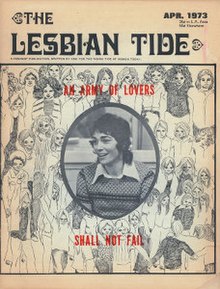 April 1973 cover | |
| Editor | Jeanne Córdova |
|---|---|
| Categories | Lesbian, feminism, politics |
| Frequency | Bimonthly |
| Publisher | Daughters of Bilitis and Jeanne Córdova |
| First issue | 1971 |
| Final issue | 1980 |
| Country | United States |
| Language | English |
The Lesbian Tide (1971–1980) was a lesbian periodical published in the United States by the Los Angeles chapter of the Daughters of Bilitis. It was the first lesbian periodical in the US to reach a national audience and the first US magazine to use the word "lesbian" in the title.
History[edit]
The Lesbian Tide originated in 1971 as the newsletter for the Los Angeles chapter of the Daughters of Bilitis (DOB), a national lesbian rights organization, and was called the LA DOB Newsletter. The newsletter was run by young members of the DOB and their radical political stance created a rift between the editors and older, less radical members of the DOB. In December 1972, the newspaper formally split from the DOB and, with a change in title to the Lesbian Tide, it became an independent publication with Jeanne Córdova (a former DOB member) as editor.[1][2]
When the Tide expanded its distribution from the Los Angeles region to other U.S. cities, it became the first national lesbian newspaper.[3] Córdova's ambition was to create a newspaper that was as widely circulated as The Advocate, which at the time was targeted towards a gay male audience.[3] The Lesbian Tide struggled financially, however, and at one point its editors published a message to their readers: "WE ARE FLAT BROKE! PLEASE SEND MONEY!"[4] Ultimately, the newspaper ceased publication in 1980.[3]
The Tide's content was not purely lesbian-related; it also appealed to the broader feminist movement of the time and advertised services such as the Alcoholism Center for Women and sex therapy workshops.[5] Wiccan feminist Cerridwen Fallingstar contributed to the magazine in the late 1970s, under her birth name Cheri Lesh.[6]
Importance[edit]
The Lesbian Tide was the United States' first national lesbian newspaper.[3] Writing for The Advocate, Diane Anderson-Minshall said that Córdova and the newspaper's other writers "helped usher in the era of advocacy journalism ... It wasn't propaganda, but it wasn't quiet, just-the-facts-ma'am reporting either."[7]
In April 1973, the staff of the Lesbian Tide organized and hosted the West Coast Lesbian Conference in Los Angeles.[1] The magazine's writers were also outspoken in their opposition of proposed censorship and obscenity laws in California, which they felt were homophobic and antifeminist.[8]
Lesbian Tide was "the newspaper of record for the lesbian feminist decade"[9] (1970–1980), ranked "highest in the criteria of journalistic excellence,"[10] and notable as the first American magazine to use the word "lesbian" in its title.[11]
References[edit]
- ^ a b Clendinen, Dudley; Nagourney, Dudley (2001). "In Our Mothers' Names". Out For Good: The Struggle to Build a Gay Rights Movement in America. Simon & Schuster. ISBN 9780684867434.
- ^ Pomerleau, Clark A. (2010). "Empowering Members, Not Overpowering Them: The National Organization for Women, Calls for Lesbian Inclusion, and California Influence, 1960s–1980s". Journal of Homosexuality. 57 (7): 842–861. doi:10.1080/00918369.2010.493414. PMID 20665327. S2CID 25760481.
- ^ a b c d Zonkel, Phillip (April 12, 2012). "'Outlaw' Jeanne Cordova to speak Sunday at Montclair Women's Cultural Arts Club". Press-Telegram.
- ^ Murray, Heather (2007). "Free for All Lesbians: Lesbian Cultural Production and Consumption in the United States during the 1970s". Journal of the History of Sexuality. 16 (2): 251–275. doi:10.1353/sex.2007.0046. PMID 19244670. S2CID 9416941.
- ^ Hobbs Thompson, Margo (2005). "The Visible Lesbian in Community Arts Journals". GLQ: A Journal of Lesbian and Gay Studies. 12 (3): 405–423.
- ^ "As The Tide Turns". Lesbian Tide. July/August 1979. p. 20.
- ^ "Sex, History And Lesbian Outlaws". The Advocate. December 3, 2011. Retrieved May 6, 2014.
- ^ Strub, Whitney (2010). "LAVENDER, MENACED: Lesbianism, Obscenity Law, and the Feminist Antipornography Movement". Journal of Women's History. 22 (2): 83–107, 212. doi:10.1353/jowh.0.0143. S2CID 144495351.
- ^ Stein, Marc (2004). Encyclopedia of Lesbian, Gay, Bisexual, and Transgender History in America. USA: Charles Scribner's Sons. pp. 259–260. ISBN 9780684312613.
- ^ Vida, Ginny (1978). Our right to love: a lesbian resource book. Prentice-Hall/National Gay Task Force. pp. 246–247. ISBN 9780136444015.
- ^ Miller, By Meredith. Historical Dictionary of Lesbian Literature.